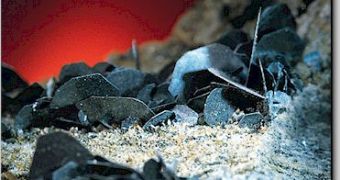NASA and one of its many contractors are planning a future Moon base, an outpost that could be reused by the crews of the next lunar missions to land on the surface in the next decades. This base camp will house astronauts, allowing them to use the moon's natural resources, conduct scientific experiments and even prepare for manned missions to Mars.
As a first step in the process, Hubble Space Telescope is being used by geologists to map and study minerals on the Moon, in what could be the next lunar gold rush. However, it's not gold scientists are trying to find, it's the titanium-dioxide-rich mineral ilmenite on the moon's surface.
"Oxygen production from TiO2-enhanced lunar soils [titanium dioxide] could potentially make breathable oxygen and even oxidizer for rocket fuel," says Jim Garvin of NASA's Goddard Space Flight Center in Greenbelt, Maryland.
A weakly magnetic iron-black or steel-gray mineral found in metamorphic and igneous rocks, this would not only produce oxygen, it could also provide a source of iron and titanium for the building and maintenance of the future base's structures.
Recent UV images on the Moon's surface, taken by Hubble, show patterns that the concentration of TiO2 measured in lunar samples collected by the Apollo missions, so scientists think these variations can be used to create a map of TiO2 abundance.
But since our planet's atmosphere negatively affects UV readings because of different interferences, the best tool astronomers can use is the large and efficient Hubble telescope, which can take UV images of a small area of the lunar surface that included the landing sites of the Apollo 15 and 17 spacecraft.
Initial tests confirmed the existence of titanium dioxide and by comparing them with Apollo samples, scientists concluded that low-lying basaltic soil has 6% to 8% TiO2 by weight, while the highland soils contain only 2%.
"Our well-calibrated UV images will act as a pathfinder for mapping by NASA's 2008 Lunar Reconnaissance Orbiter," says Garvin. Due to the extraordinary sensory abilities of Hubble, it can be many times more efficient than using rovers to sample large areas of the lunar surface.

 14 DAY TRIAL //
14 DAY TRIAL //